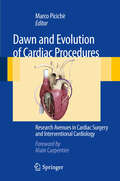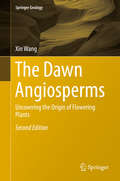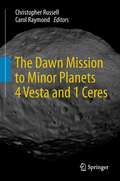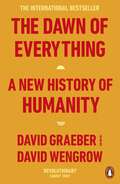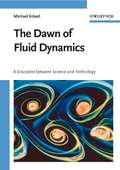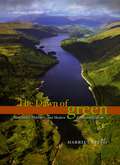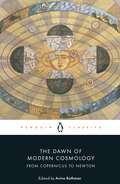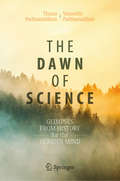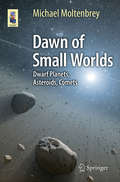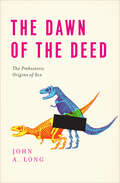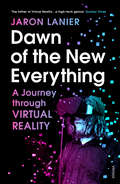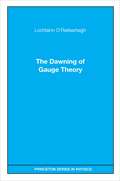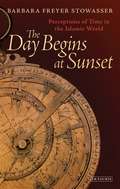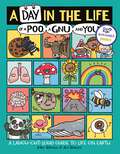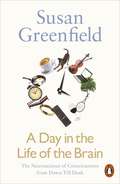- Table View
- List View
Dawn and Evolution of Cardiac Procedures: Research Avenues in Cardiac Surgery and Interventional Cardiology
by Marco PicichèMarco PicichèThe book provides a clear overview of the various research stages of cardiac surgery, interventional cardiology, and cardiac anesthesia. It also deals with recent advances in minimally invasive surgery, robotic surgery, and many other innovations introduced in this field. However, aim of this volume is not only to describe the evolution of the discipline, but also to give the occasion of revisiting old and forgotten ideas that could be used successfully also nowadays if supported by modern technologies. With contributions by renowned international experts, the volume will be a very useful tool for students, residents, cardiac surgery and anesthesia professionals, cardiologists, biomedical engineers, and researchers.
The Dawn Angiosperms: Uncovering the Origin of Flowering Plants (Springer Geology #121)
by Xin WangThis book discusses the controversial and conflicting hypotheses on the origin of angiosperms, which was generally assumed to be restricted to the Cretaceous and later ages. Since publishing the first edition of “The Dawn of Angiosperms” in 2010, several important advances have been made in this field of science, namely 1) the discovery of new fossil angiosperms from the Jurassic; 2) European researchers discovering angiosperm-like pollen from the Triassic; and most importantly 3) the discovery of a perfect flower from the Jurassic. All of these findings are at odds with the currently widely accepted evolutionary theories, and thus call upon us to critically reassess botanical theory. Accordingly, the new edition of this book not only includes more new fossil taxa, but also documents them in greater detail and corrects many commonly held misconceptions. In so doing, it makes related studies and teaching on the early history of angiosperms more realistic, concrete, and tangible, providing concrete fossil evidence as the basis for future research, and helping to distinguish the most accurate botanical hypotheses.
The Dawn Mission to Minor Planets 4 Vesta and 1 Ceres
by Christopher Russell Carol RaymondDawn is the first mission to orbit a main belt asteroid and the first scientific mission to use ion propulsion. Major objectives of this mission include mapping of the surfaces of 4 Vesta and 1 Ceres, determining its topography from stereo measurements, determining its mineralogy, measuring its elemental composition and obtaining gravity data. This book describes the Dawn mission, its exploration and scientific objectives, the instruments that accomplish those objectives, the operations plan and the education and outreach plan. It is directed to those studying asteroids and the evolution of the solar system. This volume will be a valuable reference for anyone who uses data from the instruments of the DAWN mission. Previously published in Space Science Reviews, Vol. 163/1-4, 2012.
The Dawn of Everything: A New History of Humanity
by David Graeber David Wengrow'Pacey and potentially revolutionary' Sunday Times'A boldly ambitious work ... entertaining and thought-provoking' Observer'Fascinating, thought-provoking, groundbreaking. A book that will generate debate for years to come' Rutger Bregman'This is not a book. This is an intellectual feast' Nassim Nicholas TalebFor generations, our remote ancestors have been cast as primitive and childlike - either free and equal, or thuggish and warlike. Civilization, we are told, could be achieved only by sacrificing those original freedoms or, alternatively, by taming our baser instincts. David Graeber and David Wengrow show how such theories first emerged in the eighteenth century as a reaction to indigenous critiques of European society, and why they are wrong. In doing so, they overturn our view of human history, including the origins of farming, property, cities, democracy, slavery and civilization itself.Drawing on path-breaking research in archaeology and anthropology, the authors show how history becomes a far more interesting place once we begin to see what's really there. If humans did not spend 95 per cent of their evolutionary past in tiny bands of hunter-gatherers, what were they doing all that time? If agriculture, and cities, did not mean a plunge into hierarchy and domination, then what kinds of social and economic organization did they lead to? The answers are often unexpected, and suggest that the course of history may be less set in stone, and more full of playful possibilities than we tend to assume.The Dawn of Everything fundamentally transforms our understanding of the human past and offers a path toward imagining new forms of freedom, new ways of organizing society. This is a monumental book of formidable intellectual range, animated by curiosity, moral vision and faith in the power of direct action.'A fascinating inquiry ... Challenging and illuminating' Noam Chomsky'Graeber and Wengrow have effectively overturned everything I ever thought about the history of the world. The most profound and exciting book I've read in thirty years' Robin D. G. Kelley
The Dawn of Fluid Dynamics: A Discipline Between Science and Technology
by Michael EckertThis is the first publication to describe the evolution of fluid dynamics as a major field in modern science and engineering. It contains a description of the interaction between applied research and application, taking as its example the history of fluid mechanics in the 20th century. The focus lies on the work of Ludwig Prandtl, founder of the aerodynamic research center (AVA) in Gottingen, whose ideas and publications have influenced modern aerodynamics and fluid mechanics in many fields. While suitable for others, this book is intended for natural scientists and engineers as well as historians of science and technology.
The Dawn of Green: Manchester, Thirlmere, and Modern Environmentalism
by Harriet RitvoLocated in the heart of England’s Lake District, the placid waters of Thirlmere seem to be the embodiment of pastoral beauty. But under their calm surface lurks the legacy of a nineteenth-century conflict that pitted industrial progress against natural conservation—and helped launch the environmental movement as we know it. Purchased by the city of Manchester in the 1870s, Thirlmere was dammed and converted into a reservoir, its water piped one hundred miles south to the burgeoning industrial city and its workforce. This feat of civil engineering—and of natural resource diversion—inspired one of the first environmental struggles of modern times. The Dawn of Green re-creates the battle for Thirlmere and the clashes between conservationists who wished to preserve the lake and developers eager to supply the needs of a growing urban population. Bringing to vivid life the colorful and strong-minded characters who populated both sides of the debate, noted historian Harriet Ritvo revisits notions of the natural promulgated by romantic poets, recreationists, resource managers, and industrial developers to establish Thirlmere as the template for subsequent—and continuing—environmental struggles.
The Dawn of Green: Manchester, Thirlmere, and Modern Environmentalism
by Harriet RitvoLocated in the heart of England’s Lake District, the placid waters of Thirlmere seem to be the embodiment of pastoral beauty. But under their calm surface lurks the legacy of a nineteenth-century conflict that pitted industrial progress against natural conservation—and helped launch the environmental movement as we know it. Purchased by the city of Manchester in the 1870s, Thirlmere was dammed and converted into a reservoir, its water piped one hundred miles south to the burgeoning industrial city and its workforce. This feat of civil engineering—and of natural resource diversion—inspired one of the first environmental struggles of modern times. The Dawn of Green re-creates the battle for Thirlmere and the clashes between conservationists who wished to preserve the lake and developers eager to supply the needs of a growing urban population. Bringing to vivid life the colorful and strong-minded characters who populated both sides of the debate, noted historian Harriet Ritvo revisits notions of the natural promulgated by romantic poets, recreationists, resource managers, and industrial developers to establish Thirlmere as the template for subsequent—and continuing—environmental struggles.
The Dawn of Green: Manchester, Thirlmere, and Modern Environmentalism
by Harriet RitvoLocated in the heart of England’s Lake District, the placid waters of Thirlmere seem to be the embodiment of pastoral beauty. But under their calm surface lurks the legacy of a nineteenth-century conflict that pitted industrial progress against natural conservation—and helped launch the environmental movement as we know it. Purchased by the city of Manchester in the 1870s, Thirlmere was dammed and converted into a reservoir, its water piped one hundred miles south to the burgeoning industrial city and its workforce. This feat of civil engineering—and of natural resource diversion—inspired one of the first environmental struggles of modern times. The Dawn of Green re-creates the battle for Thirlmere and the clashes between conservationists who wished to preserve the lake and developers eager to supply the needs of a growing urban population. Bringing to vivid life the colorful and strong-minded characters who populated both sides of the debate, noted historian Harriet Ritvo revisits notions of the natural promulgated by romantic poets, recreationists, resource managers, and industrial developers to establish Thirlmere as the template for subsequent—and continuing—environmental struggles.
The Dawn of Green: Manchester, Thirlmere, and Modern Environmentalism
by Harriet RitvoLocated in the heart of England’s Lake District, the placid waters of Thirlmere seem to be the embodiment of pastoral beauty. But under their calm surface lurks the legacy of a nineteenth-century conflict that pitted industrial progress against natural conservation—and helped launch the environmental movement as we know it. Purchased by the city of Manchester in the 1870s, Thirlmere was dammed and converted into a reservoir, its water piped one hundred miles south to the burgeoning industrial city and its workforce. This feat of civil engineering—and of natural resource diversion—inspired one of the first environmental struggles of modern times. The Dawn of Green re-creates the battle for Thirlmere and the clashes between conservationists who wished to preserve the lake and developers eager to supply the needs of a growing urban population. Bringing to vivid life the colorful and strong-minded characters who populated both sides of the debate, noted historian Harriet Ritvo revisits notions of the natural promulgated by romantic poets, recreationists, resource managers, and industrial developers to establish Thirlmere as the template for subsequent—and continuing—environmental struggles.
The Dawn of Green: Manchester, Thirlmere, and Modern Environmentalism
by Harriet RitvoLocated in the heart of England’s Lake District, the placid waters of Thirlmere seem to be the embodiment of pastoral beauty. But under their calm surface lurks the legacy of a nineteenth-century conflict that pitted industrial progress against natural conservation—and helped launch the environmental movement as we know it. Purchased by the city of Manchester in the 1870s, Thirlmere was dammed and converted into a reservoir, its water piped one hundred miles south to the burgeoning industrial city and its workforce. This feat of civil engineering—and of natural resource diversion—inspired one of the first environmental struggles of modern times. The Dawn of Green re-creates the battle for Thirlmere and the clashes between conservationists who wished to preserve the lake and developers eager to supply the needs of a growing urban population. Bringing to vivid life the colorful and strong-minded characters who populated both sides of the debate, noted historian Harriet Ritvo revisits notions of the natural promulgated by romantic poets, recreationists, resource managers, and industrial developers to establish Thirlmere as the template for subsequent—and continuing—environmental struggles.
The Dawn of Green: Manchester, Thirlmere, and Modern Environmentalism
by Harriet RitvoLocated in the heart of England’s Lake District, the placid waters of Thirlmere seem to be the embodiment of pastoral beauty. But under their calm surface lurks the legacy of a nineteenth-century conflict that pitted industrial progress against natural conservation—and helped launch the environmental movement as we know it. Purchased by the city of Manchester in the 1870s, Thirlmere was dammed and converted into a reservoir, its water piped one hundred miles south to the burgeoning industrial city and its workforce. This feat of civil engineering—and of natural resource diversion—inspired one of the first environmental struggles of modern times. The Dawn of Green re-creates the battle for Thirlmere and the clashes between conservationists who wished to preserve the lake and developers eager to supply the needs of a growing urban population. Bringing to vivid life the colorful and strong-minded characters who populated both sides of the debate, noted historian Harriet Ritvo revisits notions of the natural promulgated by romantic poets, recreationists, resource managers, and industrial developers to establish Thirlmere as the template for subsequent—and continuing—environmental struggles.
The Dawn of Modern Cosmology: From Copernicus to Newton
by Nicolaus Copernicus Galileo Galilei Johannes Kepler René Descartes Isaac NewtonNew to Penguin Classics, the astonishing story of the Copernican Revolution, told through the words of the ground-breaking scientists who brought it aboutIn the late fifteenth century, it was believed that the earth stood motionless at the centre of a small, ordered cosmos. Just over two centuries later, everything had changed. Not only was the sun the centre of creation, but the entire practice of science had been revolutionised. This is the story of that astonishing transformation, told through the words of the astronomers and mathematicians at its heart. Bringing together excerpts from the works and letters of Copernicus, Galileo, Kepler, Descartes, Newton and others for the first time, The Dawn of Modern Cosmology is the definitive record of one of the great turning points in human history.Edited with Translations, Notes and an Introduction by Aviva Rothman
The Dawn of Science: Glimpses from History for the Curious Mind
by Thanu Padmanabhan Vasanthi PadmanabhanThis lucid and captivating book takes the reader back to the early history of all the sciences, starting from antiquity and ending roughly at the time of Newton — covering the period which can legitimately be called the “dawn” of the sciences. Each of the 24 chapters focuses on a particular and significant development in the evolution of science, and is connected in a coherent way to the others to yield a smooth, continuous narrative. The at-a-glance diagrams showing the “When” and “Where” give a brief summary of what was happening at the time, thereby providing the broader context of the scientific events highlighted in that chapter. Embellished with colourful photographs and illustrations, and “boxed” highlights scattered throughout the text, this book is a must-read for everyone interested in the history of science, and how it shaped our world today.
Dawn of Small Worlds: Dwarf Planets, Asteroids, Comets (Astronomers' Universe)
by Michael MoltenbreyThis book gives a detailed introduction to the thousands and thousands of smaller bodies in the solar system. Written for interested laymen, amateur astronomers and students it describes the nature and origin of asteroids, dwarf planets and comets, and gives detailed information about their role in the solar system. The author nicely reviews the history of small-world-exploration and describes past, current and future space craft missions studying small worlds, and presents their results. Readers will learn that small solar system worlds have a dramatically different nature and appearance than the planets. Even though research activity on small worlds has increased in the recent past many of their properties are still in the dark and need further research.
The Dawn of the Deed: The Prehistoric Origins of Sex
by John A. LongWe all know about the birds and the bees, but what about the ancient placoderm fishes and the dinosaurs? The history of sex is as old as life itself—and as complicated and mysterious. And despite centuries of study there is always more to know. In 2008, paleontologist John A. Long and a team of researchers revealed their discovery of a placoderm fish fossil, known as “the mother fish,” which at 380 million years old revealed the oldest vertebrate embryo—the earliest known example of internal fertilization. As Long explains, this find led to the reexamination of countless fish fossils and the discovery of previously undetected embryos. As a result, placoderms are now considered to be the first species to have had intimate sexual reproduction or sex as we know it—sort of. Inspired by this incredible find, Long began a quest to uncover the paleontological and evolutionary history of copulation and insemination. In The Dawn of the Deed, he takes readers on an entertaining and lively tour through the sex lives of ancient fish and exposes the unusual mating habits of arthropods, tortoises, and even a well-endowed (16.5 inches!) Argentine Duck. Long discusses these significant discoveries alongside what we know about reproductive biology and evolutionary theory, using the fossil record to provide a provocative account of prehistoric sex. The Dawn of the Deed also explores fascinating revelations about animal reproduction, from homosexual penguins to monogamous seahorses to the difficulties of dinosaur romance and how sexual organs in ancient shark-like fishes actually relate to our own sexual anatomy. The Dawn of the Deed is Long’s own story of what it’s like to be a part of a discovery that rewrites evolutionary history as well as an absolutely rollicking guide to sex throughout the ages in the animal kingdom. It’s natural history with a naughty wink.
The Dawn of the Deed: The Prehistoric Origins of Sex
by John A. LongWe all know about the birds and the bees, but what about the ancient placoderm fishes and the dinosaurs? The history of sex is as old as life itself—and as complicated and mysterious. And despite centuries of study there is always more to know. In 2008, paleontologist John A. Long and a team of researchers revealed their discovery of a placoderm fish fossil, known as “the mother fish,” which at 380 million years old revealed the oldest vertebrate embryo—the earliest known example of internal fertilization. As Long explains, this find led to the reexamination of countless fish fossils and the discovery of previously undetected embryos. As a result, placoderms are now considered to be the first species to have had intimate sexual reproduction or sex as we know it—sort of. Inspired by this incredible find, Long began a quest to uncover the paleontological and evolutionary history of copulation and insemination. In The Dawn of the Deed, he takes readers on an entertaining and lively tour through the sex lives of ancient fish and exposes the unusual mating habits of arthropods, tortoises, and even a well-endowed (16.5 inches!) Argentine Duck. Long discusses these significant discoveries alongside what we know about reproductive biology and evolutionary theory, using the fossil record to provide a provocative account of prehistoric sex. The Dawn of the Deed also explores fascinating revelations about animal reproduction, from homosexual penguins to monogamous seahorses to the difficulties of dinosaur romance and how sexual organs in ancient shark-like fishes actually relate to our own sexual anatomy. The Dawn of the Deed is Long’s own story of what it’s like to be a part of a discovery that rewrites evolutionary history as well as an absolutely rollicking guide to sex throughout the ages in the animal kingdom. It’s natural history with a naughty wink.
The Dawn of the Deed: The Prehistoric Origins of Sex
by John A. LongWe all know about the birds and the bees, but what about the ancient placoderm fishes and the dinosaurs? The history of sex is as old as life itself—and as complicated and mysterious. And despite centuries of study there is always more to know. In 2008, paleontologist John A. Long and a team of researchers revealed their discovery of a placoderm fish fossil, known as “the mother fish,” which at 380 million years old revealed the oldest vertebrate embryo—the earliest known example of internal fertilization. As Long explains, this find led to the reexamination of countless fish fossils and the discovery of previously undetected embryos. As a result, placoderms are now considered to be the first species to have had intimate sexual reproduction or sex as we know it—sort of. Inspired by this incredible find, Long began a quest to uncover the paleontological and evolutionary history of copulation and insemination. In The Dawn of the Deed, he takes readers on an entertaining and lively tour through the sex lives of ancient fish and exposes the unusual mating habits of arthropods, tortoises, and even a well-endowed (16.5 inches!) Argentine Duck. Long discusses these significant discoveries alongside what we know about reproductive biology and evolutionary theory, using the fossil record to provide a provocative account of prehistoric sex. The Dawn of the Deed also explores fascinating revelations about animal reproduction, from homosexual penguins to monogamous seahorses to the difficulties of dinosaur romance and how sexual organs in ancient shark-like fishes actually relate to our own sexual anatomy. The Dawn of the Deed is Long’s own story of what it’s like to be a part of a discovery that rewrites evolutionary history as well as an absolutely rollicking guide to sex throughout the ages in the animal kingdom. It’s natural history with a naughty wink.
The Dawn of the Deed: The Prehistoric Origins of Sex
by John A. LongWe all know about the birds and the bees, but what about the ancient placoderm fishes and the dinosaurs? The history of sex is as old as life itself—and as complicated and mysterious. And despite centuries of study there is always more to know. In 2008, paleontologist John A. Long and a team of researchers revealed their discovery of a placoderm fish fossil, known as “the mother fish,” which at 380 million years old revealed the oldest vertebrate embryo—the earliest known example of internal fertilization. As Long explains, this find led to the reexamination of countless fish fossils and the discovery of previously undetected embryos. As a result, placoderms are now considered to be the first species to have had intimate sexual reproduction or sex as we know it—sort of. Inspired by this incredible find, Long began a quest to uncover the paleontological and evolutionary history of copulation and insemination. In The Dawn of the Deed, he takes readers on an entertaining and lively tour through the sex lives of ancient fish and exposes the unusual mating habits of arthropods, tortoises, and even a well-endowed (16.5 inches!) Argentine Duck. Long discusses these significant discoveries alongside what we know about reproductive biology and evolutionary theory, using the fossil record to provide a provocative account of prehistoric sex. The Dawn of the Deed also explores fascinating revelations about animal reproduction, from homosexual penguins to monogamous seahorses to the difficulties of dinosaur romance and how sexual organs in ancient shark-like fishes actually relate to our own sexual anatomy. The Dawn of the Deed is Long’s own story of what it’s like to be a part of a discovery that rewrites evolutionary history as well as an absolutely rollicking guide to sex throughout the ages in the animal kingdom. It’s natural history with a naughty wink.
The Dawn of the Deed: The Prehistoric Origins of Sex
by John A. LongWe all know about the birds and the bees, but what about the ancient placoderm fishes and the dinosaurs? The history of sex is as old as life itself—and as complicated and mysterious. And despite centuries of study there is always more to know. In 2008, paleontologist John A. Long and a team of researchers revealed their discovery of a placoderm fish fossil, known as “the mother fish,” which at 380 million years old revealed the oldest vertebrate embryo—the earliest known example of internal fertilization. As Long explains, this find led to the reexamination of countless fish fossils and the discovery of previously undetected embryos. As a result, placoderms are now considered to be the first species to have had intimate sexual reproduction or sex as we know it—sort of. Inspired by this incredible find, Long began a quest to uncover the paleontological and evolutionary history of copulation and insemination. In The Dawn of the Deed, he takes readers on an entertaining and lively tour through the sex lives of ancient fish and exposes the unusual mating habits of arthropods, tortoises, and even a well-endowed (16.5 inches!) Argentine Duck. Long discusses these significant discoveries alongside what we know about reproductive biology and evolutionary theory, using the fossil record to provide a provocative account of prehistoric sex. The Dawn of the Deed also explores fascinating revelations about animal reproduction, from homosexual penguins to monogamous seahorses to the difficulties of dinosaur romance and how sexual organs in ancient shark-like fishes actually relate to our own sexual anatomy. The Dawn of the Deed is Long’s own story of what it’s like to be a part of a discovery that rewrites evolutionary history as well as an absolutely rollicking guide to sex throughout the ages in the animal kingdom. It’s natural history with a naughty wink.
The Dawn of the Deed: The Prehistoric Origins of Sex
by John A. LongWe all know about the birds and the bees, but what about the ancient placoderm fishes and the dinosaurs? The history of sex is as old as life itself—and as complicated and mysterious. And despite centuries of study there is always more to know. In 2008, paleontologist John A. Long and a team of researchers revealed their discovery of a placoderm fish fossil, known as “the mother fish,” which at 380 million years old revealed the oldest vertebrate embryo—the earliest known example of internal fertilization. As Long explains, this find led to the reexamination of countless fish fossils and the discovery of previously undetected embryos. As a result, placoderms are now considered to be the first species to have had intimate sexual reproduction or sex as we know it—sort of. Inspired by this incredible find, Long began a quest to uncover the paleontological and evolutionary history of copulation and insemination. In The Dawn of the Deed, he takes readers on an entertaining and lively tour through the sex lives of ancient fish and exposes the unusual mating habits of arthropods, tortoises, and even a well-endowed (16.5 inches!) Argentine Duck. Long discusses these significant discoveries alongside what we know about reproductive biology and evolutionary theory, using the fossil record to provide a provocative account of prehistoric sex. The Dawn of the Deed also explores fascinating revelations about animal reproduction, from homosexual penguins to monogamous seahorses to the difficulties of dinosaur romance and how sexual organs in ancient shark-like fishes actually relate to our own sexual anatomy. The Dawn of the Deed is Long’s own story of what it’s like to be a part of a discovery that rewrites evolutionary history as well as an absolutely rollicking guide to sex throughout the ages in the animal kingdom. It’s natural history with a naughty wink.
Dawn of the New Everything: A Journey Through Virtual Reality
by Jaron LanierJaron Lanier, ‘the father of Virtual Reality … a high-tech genius’ (Sunday Times), tells the extraordinary story of how in just over three decades Virtual Reality went from being a dream to a reality – and how its power to turn dreams into realities will transform us and our world.Virtual Reality has long been one of the dominant clichés of science fiction. Now Virtual Reality is a reality: those big headsets that make people look ridiculous, even while radiating startled delight; the place where war veterans overcome PTSD, surgeries are trialled, aircraft and cities are designed. But VR is far more interesting than any single technology, however spectacular. It is, in fact, the most effective device ever invented for researching what a human being actually is – and how we think and feel.More than thirty years ago, legendary computer scientist, visionary and artist Jaron Lanier pioneered its invention. Here, in what is likely to be one of the most unusual books you ever read, he blends scientific investigation, philosophical thought experiment and his memoir of a life lived at the centre of digital innovation to explain what VR really is: the science of comprehensive illusion; the extension of the intimate magic of earliest childhood into adulthood; a hint of what life would be like without any limits. As Lanier shows, we are standing on the threshold of an entirely new realm of human creativity, expression, communication and experience. While we can use VR to test our relationship with reality, it will test us in return, for how we choose to use it will reveal who we truly are.Welcome to a mind-expanding, life-enhancing, world-changing adventure.
The Dawning of Gauge Theory (Princeton Series in Physics #106)
by Lochlainn O'RaifeartaighDuring the course of this century, gauge invariance has slowly emerged from being an incidental symmetry of electromagnetism to being a fundamental geometrical principle underlying the four known fundamental physical interactions. The development has been in two stages. In the first stage (1916-1956) the geometrical significance of gauge-invariance gradually came to be appreciated and the original abelian gauge-invariance of electromagnetism was generalized to non-abelian gauge invariance. In the second stage (1960-1975) it was found that, contrary to first appearances, the non-abelian gauge-theories provided exactly the framework that was needed to describe the nuclear interactions (both weak and strong) and thus provided a universal framework for describing all known fundamental interactions. In this work, Lochlainn O'Raifeartaigh describes the former phase. O'Raifeartaigh first illustrates how gravitational theory and quantum mechanics played crucial roles in the reassessment of gauge theory as a geometric principle and as a framework for describing both electromagnetism and gravitation. He then describes how the abelian electromagnetic gauge-theory was generalized to its present non-abelian form. The development is illustrated by including a selection of relevant articles, many of them appearing here for the first time in English, notably by Weyl, Schrodinger, Klein, and London in the pre-war years, and by Pauli, Shaw, Yang-Mills, and Utiyama after the war. The articles illustrate that the reassessment of gauge-theory, due in a large measure to Weyl, constituted a major philosophical as well as technical advance.
The Day Begins at Sunset: Perceptions of Time in the Islamic World (Library of Middle East History)
by Barbara Freyer StowasserThe vision of Time in the Qur'an is that of a divine gift created for the benefit of humankind. Night and day, and the twelve lunar months of the year, are 'appointed times for the believing people'. Reading the sky for the prayers of the hour has thus for Muslims been a constant reminder of God's providence and power. In her absorbing and illuminating new book, the late Barbara Freyer Stowasser examines the various ways in which Islam has structured, ordered and measured Time. Drawing on examples from Judaism and Christianity, as well as the ancient world, the author shows that while systems of time facilitate the orderly function of vastly different civilizations, in Islam they have always been fundamental. Among other topics, she discusses the Muslim lunar calendar; the rise of the science of astronomy; the remarkable career of al-Biruni, greatest authority in Muslim perceptions of Time; and the impact of technologies like the astrolabe, Indian numerals and paper. The fullest account of the fascinating nexus between Islam and Time ever written, this is a major contribution to the wider history of ideas and religion.
A Day in the Life of a Poo, a Gnu and You (Winner of the Blue Peter Book Award 2021)
by Mike BarfieldWINNER OF THE BLUE PETER BOOK AWARD 2021___________If you've ever wanted to know what a panda does all day long, how your heart manages to shift all that blood around your body or what makes a rainbow shine, you've come to the right book. A Day in the Life of a Poo, a Gnu and You features the answers to all of these questions and many more, all told in a super-fun comic book format in three awesome sections: Human Body, Animal Kingdom and Earth and Science. A Day in the Life... is packed with facts, laughs and amazing illustrations you can dive into all day long. Meet your grumpy liver that has to do practically EVERYTHING; your trusty hands that are very, well, handy; the spiky porcupines ready to charge; lonely Mars rovers abandoned on the Red Planet; raging tornadoes ready to rip through the pages of the book and bubbly volcanoes ready to blow. All entries are told in the fun, friendly and informative style of Mike Barfield, and are brought to life by the colour-explosion of Jess Bradley's awesome illustrations.
A Day in the Life of the Brain: The Neuroscience of Consciousness from Dawn Till Dusk
by Susan GreenfieldEach of us has a unique, subjective inner world, one that we can never share directly with anyone else. But how do our physical brains actually give rise to this rich and varied experience of consciousness? In this ground-breaking book, internationally acclaimed neuroscientist Susan Greenfield brings together a series of astonishing new, empirically based insights into consciousness as she traces a single day in the life of your brain. From waking to walking the dog, working to dreaming, Greenfield explores how our daily experiences are translated into a tangle of cells, molecules and chemical blips, thereby probing the enduring mystery of how our brains create our individual selves.
